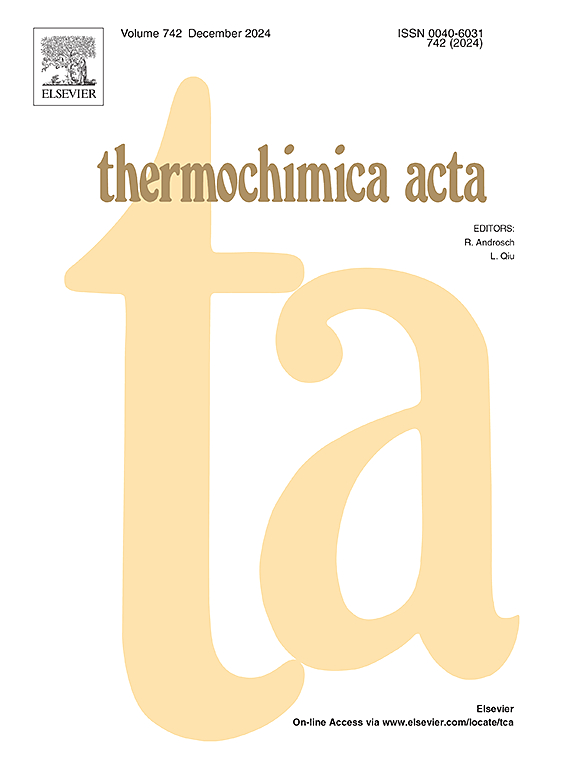电喷涂与机械混合法制备Al-MO/PVDF (MO=ZnO & ZnFe2O4)铝热剂的结构与燃烧性能对比研究
IF 3.1
2区 化学
Q2 CHEMISTRY, ANALYTICAL
引用次数: 0
摘要
铝铝热剂在能源密集型应用中显示出强大的潜力,但确保稳定的纳米级分散和优化燃烧性能是具有挑战性的。本研究通过电喷涂和机械混合制备了Al-MO /PVDF热剂(MO = ZnO, ZnFe₂O₄),比较了颗粒形貌和成分均匀性对反应性的影响。电喷样品形成近球形的亚微米颗粒,反应物分布均匀,而机械混合样品聚集成更大的不规则团簇。差示扫描量热法显示,电喷涂热剂的放热峰更明显,表明反应物接触增强,而机械混合热剂的放热峰更宽,重叠。x射线衍射显示在快速溶剂蒸发作用下部分非晶化和核壳形成。激光点火测试表明,在电喷涂配方中,特别是Al-ZnFe₂O₄/PVDF,其点火速度更快,火焰温度更高,燃烧强度更强,表现出二次热释放(微爆炸)。电喷雾辅助制造改善了均匀性,促进了快速高温反应,增强了燃烧性能。本文章由计算机程序翻译,如有差异,请以英文原文为准。

A comparative structural and combustion study of Al-MO/PVDF (MO=ZnO & ZnFe2O4) thermites synthesised by electrospraying and mechanical mixing
Aluminised thermites show strong potential for energy-intensive applications, but ensuring stable nanoscale dispersion and optimising combustion performance is challenging. This study prepared Al–MO/PVDF thermites (MO = ZnO, ZnFe₂O₄) by electrospraying and mechanical mixing to compare how particle morphology and compositional uniformity affect reactivity. Electrosprayed samples formed near-spherical, submicron particles with homogeneous distributions of reactants, whereas mechanically mixed samples aggregated into larger, irregular clusters. Differential scanning calorimetry revealed sharper, staged exothermic peaks in the electrosprayed thermites, indicating enhanced reactant contact, while the mechanically mixed thermites produced broad, overlapping exotherms. X-ray diffraction showed partial amorphisation and core-shell formation under rapid solvent evaporation. Laser ignition tests demonstrated faster ignition, higher flame temperatures, and more intense combustion in electrosprayed formulations, particularly Al–ZnFe₂O₄/PVDF, which exhibited a secondary heat release (micro-explosion). Electrospray-assisted fabrication improved homogeneity and promoted rapid, high-temperature reactions for enhanced combustion performance.
求助全文
通过发布文献求助,成功后即可免费获取论文全文。
去求助
来源期刊

Thermochimica Acta
化学-分析化学
CiteScore
6.50
自引率
8.60%
发文量
210
审稿时长
40 days
期刊介绍:
Thermochimica Acta publishes original research contributions covering all aspects of thermoanalytical and calorimetric methods and their application to experimental chemistry, physics, biology and engineering. The journal aims to span the whole range from fundamental research to practical application.
The journal focuses on the research that advances physical and analytical science of thermal phenomena. Therefore, the manuscripts are expected to provide important insights into the thermal phenomena studied or to propose significant improvements of analytical or computational techniques employed in thermal studies. Manuscripts that report the results of routine thermal measurements are not suitable for publication in Thermochimica Acta.
The journal particularly welcomes papers from newly emerging areas as well as from the traditional strength areas:
- New and improved instrumentation and methods
- Thermal properties and behavior of materials
- Kinetics of thermally stimulated processes
 求助内容:
求助内容: 应助结果提醒方式:
应助结果提醒方式:


